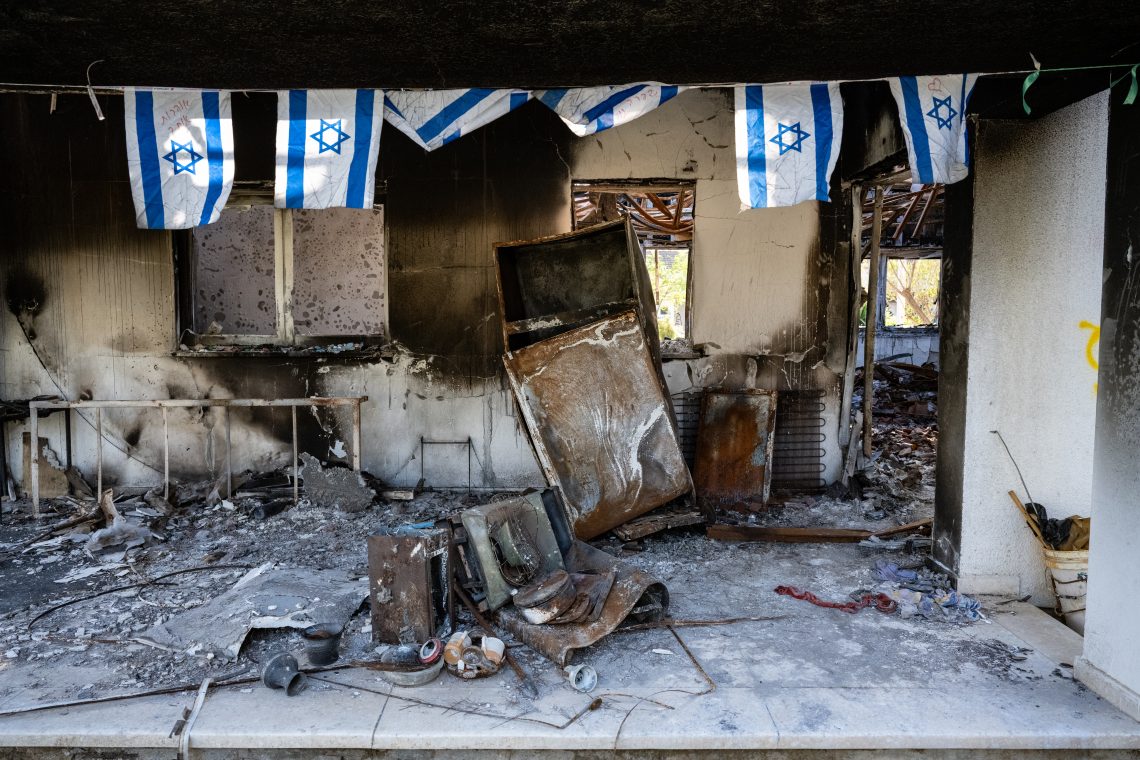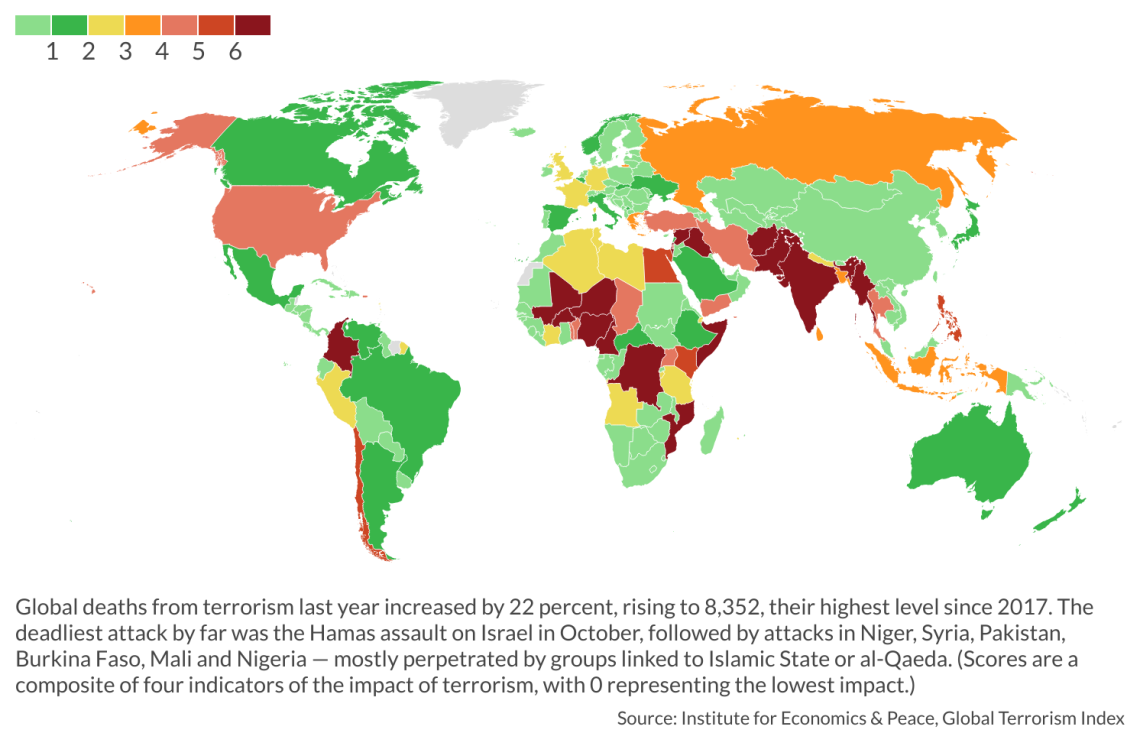The persistent threat of global terrorism
The world is likely to remain vulnerable to terror attacks, given emboldened state sponsors like Iran, fragile states like Afghanistan and opportune targets around elections in Europe and Asia.

In a nutshell
- 2023 was an especially deadly year for terror attacks
- ISIS has evolved into a network of capable regional affiliates
- Iran will likely continue to support terror proxies, despite the risks
International terrorism, perpetrated by the likes of al-Qaeda and Islamic State, kept the world living on a knife’s edge for nearly two decades following the 9/11 attacks. Until recently, public concern about terrorist threats seemed to have receded. After the defeat of Islamic State in Iraq and Syria (ISIS) five years ago, terrorism understandably faded in the minds of many (though not all) politicians, policymakers and the public.
Hamas’s devastating assault on Israel in October 2023 and ISIS’s brutal attack on Moscow in late March 2024 should serve to jolt the international policy community out of its complacency on the threat of terrorism. It is now clear that a reevaluation of the risks posed by international terrorism and its potential impact on global stability is necessary, as violent extremism will persist and possibly increase.
Hamas’s wake-up call
Hamas’s attack on Israel last fall was unexpected even by Israel, a state with one of the most highly capable intelligence services in the world. The assault also served as a perfect example of a low-probability, high-consequence terrorist event, replete with wide-ranging political, economic and security consequences.
Today, going on six months of war between Israel and Hamas, the Middle East and its periphery are deeply unsettled. There are serious concerns about a broader regional conflagration that could involve the United States, Israel, Arab states, Lebanese Hezbollah, Syria and Iran, further undermining global stability, which is already challenged by the two-plus-year-old Russo-Ukrainian war.
For example, in opposition to Israel’s offensive in Gaza, Yemeni Houthi rebels have attacked international shipping targets in the Red Sea with Iran-supplied weapons, drawing American and British military retaliation. As a result, maritime shipping and insurance rates have skyrocketed and sea-borne supply chains have been interrupted. Much of the Red Sea’s maritime traffic is now diverting around Africa’s Cape of Good Hope for safety, vastly increasing shipping times and cost.
Weak national governments and porous borders allow terror groups to find safe places to plan, operate and move easily between countries.
The Gaza war has also short-circuited the promising diplomatic engagement between Israel and Saudi Arabia and has chilled the rapprochement between Saudi Arabia and Iran. International and internal political and social tensions over the conflict have also risen in many countries outside the Middle East, including in the United States and Europe.
The larger point is that a terrorist event – even if localized – can have outsized political, economic and security repercussions. With this in mind, let us take a brief tour through the major terror actors that have the capacity to undermine stability and prosperity – locally, regionally and globally.
Iran as a state sponsor
Support from a nation-state is often critical to non-state actors such as terror groups and insurgent movements. State governments are generally those with the resources – including funding, weaponry, training and even intelligence – that can make smaller allies and proxies more effective in advancing their causes and mutual interests.
Washington has long considered Iran the foremost state sponsor of terrorism. Through its Islamic Revolutionary Guards Corps (IRGC), Tehran trains, equips and advises several Middle Eastern terrorist and militant organizations, including Hamas and Palestinian Islamic Jihad (in Gaza and the West Bank), Hezbollah (Lebanon and Syria), Kata’ib Hezbollah (Iraq) and the Houthis (Yemen). These groups loosely form Iran’s infamous “axis of resistance.”
Tehran has worked with the Taliban in Afghanistan to advance its anti-Western agenda, and its relationship with al-Qaeda has long been murky and troubling. While sectarianism is an important dynamic in Middle Eastern politics, the Iranian Shia regime has no problem aligning itself with like-minded Sunni groups that support its ambitions, such as the Taliban and Hamas.
Due to its perceived success in using proxy militant groups since 1979, Tehran is likely to continue supporting terror groups and surrogates that amplify Iran’s ability to advance and protect its interests and provoke and punish its enemies.
Read more about terrorism
- Iran works to spread its revolutionary message
- Russia will unleash chaos in the Sahel
- Behind Israel’s momentous failure
Islamic State seeks another caliphate
ISIS lost all of its territory in Iraq and Syria by spring of 2019, and has lost four senior leaders since then to counterterror operations. Yet while Islamic State is bloodied, it is not necessarily bowed. The allure of an “idyllic” Islamic caliphate – which it fundamentally achieved for a three-year period – still motivates supporters.
Some 10,000 ISIS fighters and 50,000 associated others (including the family members of fighters) are currently jailed or held in camps in Syria. Many of their countries of origin refuse to repatriate them due to concerns that they include ISIS sympathizers who will radicalize and recruit others to their cause, bringing radicalism and violence back home.
A large breakout from a prison or camp – something that has been tried before – could catalyze a revitalization of what was once the world’s largest and richest “terrorist army,” a force that took and held territory in two sovereign states for a few years.
Even now, ISIS is still operationally active, especially through its affiliates beyond Iraq and Syria. ISIS has terror branches, networks and cells in Afghanistan, Pakistan, India, the Philippines and Yemen, as well as in African countries like Egypt, Libya, Nigeria, Somalia, the Democratic Republic of Congo, Mali and Mozambique.
Facts & figures
Until lately, the success of ISIS’s African affiliates had led some to conclude that the continent was the global epicenter of the Islamic jihadist movement. Indeed, Africa’s Sahel region has been a particular hotspot, afflicted by the presence of both ISIS and al-Qaeda elements.
But recent high-profile international attacks by Afghanistan-based ISIS-Khorasan (ISIS-K) have raised its visibility markedly. ISIS-K claimed responsibility for the January bombings at a memorial for IRGC general Qassim Suleimani in Iran, which killed nearly 100 people. It also perpetrated the recent deadly shooting attacks in Moscow that killed over 130 people. And, in August 2021, ISIS-K launched a dramatic attack on the Kabul airport during the U.S. withdrawal, killing both civilians and American forces.
ISIS-K operatives have also reportedly been involved in other unsuccessful terror plots in Russia, Germany and Sweden; France and Italy have raised their security levels. It is clear that this group has objectives – and reach – beyond Afghanistan.
Will the Taliban provide a safe haven?
With the Taliban now the presiding government of Afghanistan, there is worry among policymakers and observers that the South Asian country will once again become a safe harbor for international jihadists, as it was before the 9/11 attacks.
The fact that al-Qaeda leader Ayman al-Zawahiri was killed in Kabul in 2022 indicates ongoing Taliban ties to the terror group. Al-Qaeda in the Indian Subcontinent (AQIS) also operates out of Afghanistan to advance its agenda across South Asia, including against Pakistan and India.
The Taliban does not rule Afghanistan unopposed. ISIS-K is a major challenger for power, and the Taliban does not have the ability or capacity to end the insurgency. ISIS-K has undertaken several high-profile attacks inside Afghanistan, undermining confidence in Taliban governance and the group’s ability to provide safety and security.
Meanwhile, Pakistan is one of the most terror-afflicted countries in the world, with nearly 1,500 fatalities in 2023, and is home to at least 15 reported terrorist groups. The most powerful among them is the Tehrik-i-Taliban Pakistan (TTP), an ally of both the Afghan Taliban and al-Qaeda that seeks to overthrow the (nuclear-armed) Pakistani government.
The resilient al-Qaeda
Perhaps the most infamous name in modern terrorism, al-Qaeda is now seemingly a shadow of its 9/11 self. The death of its leader, Zawahiri, has left al-Qaeda Core, the central part of the organization, without a high-profile helmsman to recruit, radicalize or propagandize.
That said, the group is resilient. There is little debate that it is still interested in reinvigorating itself to advance its Islamist agenda and to compete with Islamic State for funding, foot soldiers and fame. Although the global threat posed by al-Qaeda is not what it was in the early days after 9/11, it still maintains significant affiliates around the world to advance its Islamist, anti-Western goals and its dream of creating a caliphate.
Take East Africa’s al-Shabaab, which the U.S. State Department calls “one of al-Qaeda’s most dangerous affiliates,” responsible for killing “thousands of people, including Americans, in Somalia and across East Africa.” Besides its destabilizing of East Africa, U.S. policymakers are concerned about al-Shabaab sponsoring terror attacks on American soil. Other al-Qaeda partners can be found in the Middle East, South Asia, the Levant, the Maghreb, the Sahel and the Arabian Peninsula.
Scenarios
Less likely: The threat of terrorism decreases
It is conceivable that the grievances that terrorists say drive their hostility could be addressed at several levels, and that the use of terrorism as a tool to coerce government policies through violence against innocents will diminish.
Peace, based on political agreements between warring parties, could take hold in regions afflicted by terrorism and insurgencies, reducing the perceived need for the use of force against the government and the populace. A decreased appetite for the brutality of terrorism among the public in afflicted areas could also help starve terror groups of the supporters, soldiers, money and freedom needed to operate.
Persistent pressure from counterterror operations involving international cooperation, law enforcement, intelligence, military, financial and informational means would limit the opportunities for terror groups to survive and thrive.
However, these means of reducing the threat of international terrorism are unlikely to succeed – owing to current conflicts, ongoing political differences, the effectiveness of terrorism in highlighting causes and inflicting fear, and governmental capacity being overstretched by conflicts and great power competition.
More likely: The threat of terrorism increases
While global terrorist threats overall have arguably diminished in the public mind in recent years, terrorism is either aflame or smoldering in various parts of the world. With political and sectarian tensions elevated, especially in the Middle East, violent extremism could spread quickly, as evidenced by recent plots and attacks.
Iran will almost certainly continue to support its terrorist proxies to advance its anti-American, anti-Israeli, anti-Western agenda. While Tehran tries to maintain some degree of plausible deniability for its actions, its support of terror proxies is a double-edged sword that could bring unintended consequences. Some have called for direct Western attacks on Iran due to its support of militant groups like Hamas, the Houthis and Kata’ib Hezbollah. Such an approach could lead to a wider conflagration in the Middle East, with broader consequences for global economic and political stability.
Weak national governments and porous borders are also troubling, as they allow terror groups to find safe places to plan, train, operate and move easily between countries. As mentioned earlier, Afghanistan is an area of particular concern in this respect, following the withdrawal of the Western coalition forces that maintained pressure on terror groups, including those with international ambitions and reach.
Technological changes could also empower terror groups, especially in areas like drones. Small, inexpensive, armed first-person-view drones are having significant effects on the battlefield in Ukraine and beyond. Artificial intelligence, including the use of deepfakes, may be used for nefarious purposes – serving alongside social media as a force multiplier for extremists, for the purposes of radicalization, recruitment and retention.
With a large number of elections being held worldwide this year, including in the United States, India, Indonesia and across Europe, the chances of related terrorist violence are significant. More than 50 attacks took place during Pakistan’s recent elections.
The summer Olympics will also be staged in Paris this year and could provide an opportunity for an attack at a crowded, high-visibility venue that would draw worldwide attention. Mass casualty strikes at symbolic sites are attractive to terror groups seeking global media attention to promote their extremist causes.
While the specific threats have changed over the last five years since the fall of ISIS’s caliphate, the menace of international terrorism will remain with us and could worsen. Terrorist acts can be perpetrated with limited resources and minimal costs and yet achieve significant results. Unfortunately, violent extremists have recently demonstrated a continued desire and ability to project power internationally.
The success of recent attacks will only embolden and encourage terror groups. As such, for the short term, terror groups will likely continue to use violence to destabilize governments, interrupt peace efforts, highlight incendiary causes, recruit soldiers and supporters and secure bases of operation.
For industry-specific scenarios and bespoke geopolitical intelligence, contact us and we will provide you with more information about our advisory services.










